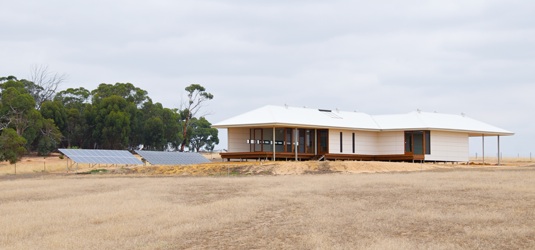Green Energy
- The Growing Economic Case For Renewable Energy
By Nick Lawton, Policy AnalystThe economic case for renewables continues to become stronger. Solar and wind energy facilities are simultaneously becoming more efficient and less costly. Today, in terms of levelized cost of energy...
- Alternative Energy: Close To The Floor?
Many European governments have recently faced unprecedented debt problems and low growth forecasts. Due to the increasing need to implement strict austerity measures, policy makers are willing to reassess the various expenses, including grant programs....
- Australian Carbon Tax Not Too Burdensome On Energy Bills - Origin Ceo
By Ross Kelly Published Dow Jones Newswires SYDNEY -(Dow Jones)- Australia's carbon tax won't have a significant impact on the country's household electricity prices, which will remain competitive with those in other developed countries, the...
- Clean Energy Week
Australia's peak body for renewable energy has welcomed Opposition Leader Tony Abbott's renewed commitment yesterday to the national 20 per cent Renewable Energy Target (RET). Clean Energy Council Chief Executive Matthew Warren said the Howard...
- Wind And Solar Power Paired With Storage Could Power Grid 99.9 Percent Of The Time
Article published in www.sciencedaily.com on december 10th 2012 Renewable energy could fully power a large electric grid 99.9 percent of the time by 2030 at costs comparable to today's electricity expenses, according to new research by the University...
Green Energy
BNEF: PV will be cheaper than fossil fuels in Australia by 2020
Article published on www.pv-magazine.com on February, 8th 2013
Bloomberg New Energy Finance (BNEF) forecasts that large-scale photovoltaic systems will supply energy cheaper than coal and gas by 2020 in Australia. Already, it states, wind farms are supplying energy cheaper than its fossil fuel counterparts.
The results from BNEF’s Sydney analysis team, which modeled the cost of generating electricity in Australia from different sources, predicts that the Australian economy can increasingly look forward to electricity generated from renewable energy sources, with new coal-fired plants being "just too expensive".
 |
| By 2020, BNEF forecasts that PV will be cheaper than coal and gas in Australia, when factoring in carbon prices. |
Additionally, the team states that unless natural gas prices in Asia-Pacific decrease, and remain low, investment in new fossil fuel power generation is likely to be limited.
The BNEF study has found that electricity from a new wind farm can currently be supplied for AU$143/MWh, compared to $143/MWh from a new coal plant, or $116/MWh from a new baseload gas plant.
While these figures take into account the cost of emissions under the government’s carbon pricing scheme, BNEF says that wind is still 14% cheaper than new coal, and 18% cheaper than new gas when the carbon price is excluded.
It must be noted, however, that new wind plants cannot compete with existing coal and gas plants, adds BNEF, thus stating the case for the need for continued policy support.
In terms of photovoltaics, BNEF says that costs have fallen by 29% since 2011. By 2020, it forecasts, large-scale photovoltaics will also be cheaper than coal and gas, when factoring in carbon prices. Wind costs, meanwhile, are said to have dropped 10%.
In contrast, energy costs from fossil fuel plants are said to be rising. "It is very unlikely that new coal-fired power stations will be built in Australia. They are just too expensive now, compared to renewables," states Kobad Bhavnagri, head of clean energy research for Bloomberg New Energy Finance in Australia.
He adds, "Even baseload gas may struggle to compete with renewables. Australia is unlikely to require new baseload capacity until after 2020, and by this time wind and large-scale PV should be significantly cheaper than burning expensive, export-priced gas. By 2020-30 we will be finding new and innovative ways to deal with the intermittency of wind and solar, so it is quite conceivable that we could leapfrog straight from coal to renewables to reduce emissions as carbon prices rise."
"The perception that fossil fuels are cheap and renewables are expensive is now out of date," says Michael Liebreich, chief executive of BNEF.
For more information about our innovative solar systems, visit our website !
- The Growing Economic Case For Renewable Energy
By Nick Lawton, Policy AnalystThe economic case for renewables continues to become stronger. Solar and wind energy facilities are simultaneously becoming more efficient and less costly. Today, in terms of levelized cost of energy...
- Alternative Energy: Close To The Floor?
Many European governments have recently faced unprecedented debt problems and low growth forecasts. Due to the increasing need to implement strict austerity measures, policy makers are willing to reassess the various expenses, including grant programs....
- Australian Carbon Tax Not Too Burdensome On Energy Bills - Origin Ceo
By Ross Kelly Published Dow Jones Newswires SYDNEY -(Dow Jones)- Australia's carbon tax won't have a significant impact on the country's household electricity prices, which will remain competitive with those in other developed countries, the...
- Clean Energy Week
Australia's peak body for renewable energy has welcomed Opposition Leader Tony Abbott's renewed commitment yesterday to the national 20 per cent Renewable Energy Target (RET). Clean Energy Council Chief Executive Matthew Warren said the Howard...
- Wind And Solar Power Paired With Storage Could Power Grid 99.9 Percent Of The Time
Article published in www.sciencedaily.com on december 10th 2012 Renewable energy could fully power a large electric grid 99.9 percent of the time by 2030 at costs comparable to today's electricity expenses, according to new research by the University...
